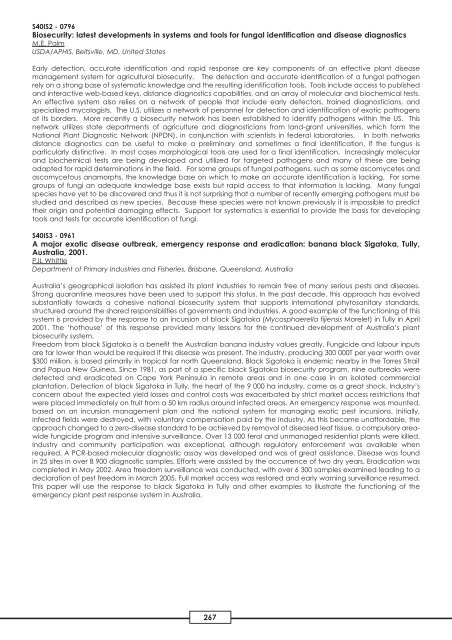Handbook Part 2 - International Mycological Association
Handbook Part 2 - International Mycological Association
Handbook Part 2 - International Mycological Association
Create successful ePaper yourself
Turn your PDF publications into a flip-book with our unique Google optimized e-Paper software.
S40IS2 - 0796<br />
Biosecurity: latest developments in systems and tools for fungal identification and disease diagnostics<br />
M.E. Palm<br />
USDA/APHIS, Beltsville, MD, United States<br />
Early detection, accurate identification and rapid response are key components of an effective plant disease<br />
management system for agricultural biosecurity. The detection and accurate identification of a fungal pathogen<br />
rely on a strong base of systematic knowledge and the resulting identification tools. Tools include access to published<br />
and interactive web-based keys, distance diagnostics capabilities, and an array of molecular and biochemical tests.<br />
An effective system also relies on a network of people that include early detectors, trained diagnosticians, and<br />
specialized mycologists. The U.S. utilizes a network of personnel for detection and identification of exotic pathogens<br />
at its borders. More recently a biosecurity network has been established to identify pathogens within the US. This<br />
network utilizes state departments of agriculture and diagnosticians from land-grant universities, which form the<br />
National Plant Diagnostic Network (NPDN), in conjunction with scientists in federal laboratories. In both networks<br />
distance diagnostics can be useful to make a preliminary and sometimes a final identification, if the fungus is<br />
particularly distinctive. In most cases morphological tools are used for a final identification. Increasingly molecular<br />
and biochemical tests are being developed and utilized for targeted pathogens and many of these are being<br />
adapted for rapid determinations in the field. For some groups of fungal pathogens, such as some ascomycetes and<br />
ascomycetous anamorphs, the knowledge base on which to make an accurate identification is lacking. For some<br />
groups of fungi an adequate knowledge base exists but rapid access to that information is lacking. Many fungal<br />
species have yet to be discovered and thus it is not surprising that a number of recently emerging pathogens must be<br />
studied and described as new species. Because these species were not known previously it is impossible to predict<br />
their origin and potential damaging effects. Support for systematics is essential to provide the basis for developing<br />
tools and tests for accurate identification of fungi.<br />
S40IS3 - 0961<br />
A major exotic disease outbreak, emergency response and eradication: banana black Sigatoka, Tully,<br />
Australia, 2001.<br />
PJL Whittle<br />
Department of Primary Industries and Fisheries, Brisbane, Queensland, Australia<br />
Australia’s geographical isolation has assisted its plant industries to remain free of many serious pests and diseases.<br />
Strong quarantine measures have been used to support this status. In the past decade, this approach has evolved<br />
substantially towards a cohesive national biosecurity system that supports international phytosanitary standards,<br />
structured around the shared responsibilities of governments and industries. A good example of the functioning of this<br />
system is provided by the response to an incursion of black Sigatoka (Mycosphaerella fijiensis Morelet) in Tully in April<br />
2001. The ‘hothouse’ of this response provided many lessons for the continued development of Australia’s plant<br />
biosecurity system.<br />
Freedom from black Sigatoka is a benefit the Australian banana industry values greatly. Fungicide and labour inputs<br />
are far lower than would be required if this disease was present. The industry, producing 300 000T per year worth over<br />
$300 million, is based primarily in tropical far north Queensland. Black Sigatoka is endemic nearby in the Torres Strait<br />
and Papua New Guinea. Since 1981, as part of a specific black Sigatoka biosecurity program, nine outbreaks were<br />
detected and eradicated on Cape York Peninsula in remote areas and in one case in an isolated commercial<br />
plantation. Detection of black Sigatoka in Tully, the heart of the 9 000 ha industry, came as a great shock. Industry’s<br />
concern about the expected yield losses and control costs was exacerbated by strict market access restrictions that<br />
were placed immediately on fruit from a 50 km radius around infected areas. An emergency response was mounted,<br />
based on an incursion management plan and the national system for managing exotic pest incursions. Initially,<br />
infected fields were destroyed, with voluntary compensation paid by the industry. As this became unaffordable, the<br />
approach changed to a zero-disease standard to be achieved by removal of diseased leaf tissue, a compulsory areawide<br />
fungicide program and intensive surveillance. Over 13 000 feral and unmanaged residential plants were killed.<br />
Industry and community participation was exceptional, although regulatory enforcement was available when<br />
required. A PCR-based molecular diagnostic assay was developed and was of great assistance. Disease was found<br />
in 25 sites in over 8 900 diagnostic samples. Efforts were assisted by the occurrence of two dry years. Eradication was<br />
completed in May 2002. Area freedom surveillance was conducted, with over 6 300 samples examined leading to a<br />
declaration of pest freedom in March 2005. Full market access was restored and early warning surveillance resumed.<br />
This paper will use the response to black Sigatoka in Tully and other examples to illustrate the functioning of the<br />
emergency plant pest response system in Australia.<br />
267









